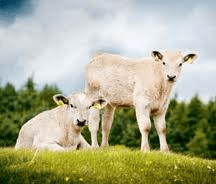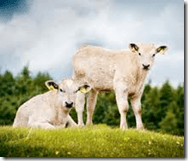A marked improvement in margins is needed across all beef enterprises to allow them to reinvest and pay a decent wage to the farmer.
While better retail prices remain fundamental if sums are to stack up, producers can also do much to improve the figures through better cost management, says Mark Topliff, economist at the Agriculture and Horticulture Development Board.
Figures gleaned from EBLEX Business Pointers, covering the financial performance of English beef sectors during the year to 31 March 2010, show costs remain the biggest differentiator between the top third, average and bottom third of producers concerning the bottom line.
And, given their inexorable climb, getting a grip on those costs will be increasingly important to businesses who are in the job for the long term, says Mr Topliff.
"Despite a general increase in costs, the best-performing producers – except for cattle finishing herds – increased their margins through a combination of good physical performance and cost control, while achieving better livestock prices.
"However, costs will have increased further since these figures were compiled, so it is likely margins will tighten when the next figures are released this autumn."
All costs must be included for a true picture of business health, says Mr Topliff. "Non-cash costs, including unpaid family labour, are often ignored, but can have a big influence on the bottom line."
Suckler herds
The major difference between the best performing suckler herds and the rest is the level of fixed costs. "These accounted for about 63% of total cash costs in the bottom third of LFA herds, compared with 58% for the top third," says Mr Topliff.
Paid labour and costs associated with power and machinery are two major areas worthy of attention, says Mr Topliff. "There are some massive differences here. The top third’s paid labour bill, at £38 a cow, was half of the bottom third’s, and farmers in the top group were paying £44 a cow less for power and machinery repairs, contractor charges and machinery depreciation.
"Some farms are over-mechanised – they have more tractors than they need, and when they have a reasonable year they often buy more machinery, which pushes up depreciation charges dramatically.
"Farm structure can also have a big effect – it may be spread out across several holdings. This can affect labour charges, including family labour, for which the bottom third of farms paid £161 a cow on average, £34 a cow more than the top third. A high figure like this suggests the group finds jobs for people who would be better off being employed part-time or working on another enterprise on or off the farm."
Sales were also significantly higher in the top group, by just over £80 a cow in LFA herds. "This is due to the higher average number of calves reared per 100 cows – 3.5% higher at 90.5 – and the fact they were sold at heavier weights – 298kg compared with 287kg for the bottom third. So although they are spending less on variable costs, the top group is, through better management, enabling stock to make more efficient use of feed and forage."
But even the top third of farms had negative margins after non-cash costs are taken in to account. "There is such a high cost attributed to the cow that the calf return is unable to cover it," he says. "It shows why the single farm payment is still so important as an income stream for suckler enterprises."
Intensive finishing
The difference between the net margins of the best intensive finishers and the rest was much smaller than other beef enterprises. As expected, the variation in fixed cost expenditure was also reduced, though it remains a crucial differentiator.
The importance of costing family labour is illustrated here – while the bottom third spent £37 a head less on paid labour, it spent almost as much extra on work done by family members, negating any saving.
But the real difference was on machinery-associated costs – the bottom third spent almost £120 a head on repairs, contracting and depreciation, three times the amount spent by the top third of producers.
The difference in output is also key. "The top group achieved sales of £944.50 a head, £91 better than the bottom group. Looking at the physical attributes reveals why the best are better – they take on lighter animals but finish them heavier, and while this may take longer, they achieve a better daily liveweight gain of 1.29kg compared with 0.92kg."
Feed expenditure provides some clues to management. The top third spent more on feed and forage, at £188.54 a head, compared with £151.21. "This is to be expected, as they are keeping animals longer and finishing them at higher weights, but they are achieving better feed conversion ratios too.
"The top third are relying less on cereals, using more by-products and alternative feeds – anything with a nutrient value but which is cheaper. This will help them as cereals prices rise. Other committed beef producers face a hard choice – do they feed grain to cattle and make a low margin or sell it on the open market and make money?"
Extensive finishing
The bottom third of extensive finishers achieved a significantly better output than the rest, but a bigger feed spend (+£52) and higher fixed costs more than wiped out that advantage. On average, the group spent almost twice as much on labour at £70 a head and £30 a head more on unpaid labour, while machinery costs were almost double.
"It’s also worth noting that while output was less for the top third, this is because they were finishing fewer animals. They were actually achieving a better return per animal, at £931 a head compared with £871, partly because they were selling them heavier, but also because they are more likely to be targeting specific breeds at specific markets. That might be Hereford, Aberdeen Angus or good Continental breeds, sold reasonably lean to meet tight classification specs at abattoirs."
Rearer/finisher herds
Again, fixed costs play a key role in terms of business performance. "Differences really stand out in this type of enterprise, with almost £300 a head difference between the top and bottom groups," says Mr Topliff.
As well as the same two culprits as before, property charges among the bottom third were the highest of any enterprise type, at over £109 a head and over three times that paid by the top group.
"Producers are having to pay the costs of keeping cows as well as rearing calves, which can be very expensive if not managed correctly," says Mr Topliff. "There are also some noticeable differences in terms of feed. The top third spent the same on other feeds as they did on concentrates, and a bit less on forage, while at the other end of the scale, concentrates and forage made up a bigger proportion of the diet. Daily liveweight gain was significantly less, at 0.82kg a head compared with 1.1kg for the best performers."
http://www.fwi.co.uk/Articles/2011/07/30/128113/Beef-profitability-What39s-holding-herds-back.htm


Deprecated: strpos(): Passing null to parameter #1 ($haystack) of type string is deprecated in /home/agriviek8Qv/agriviet.net/public_html/wp-includes/comment-template.php on line 2522